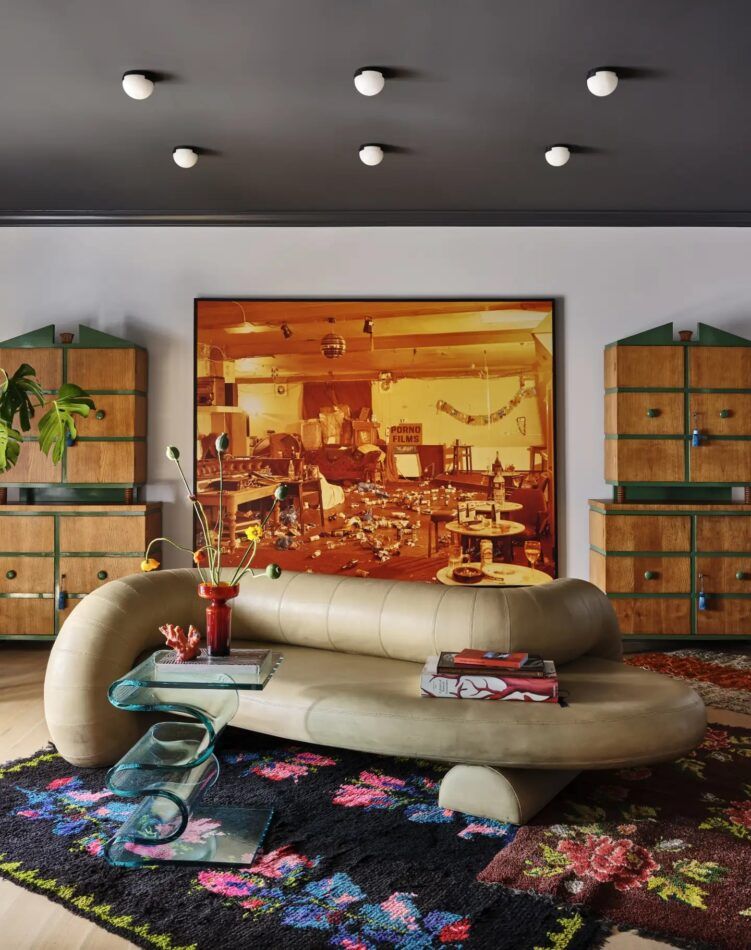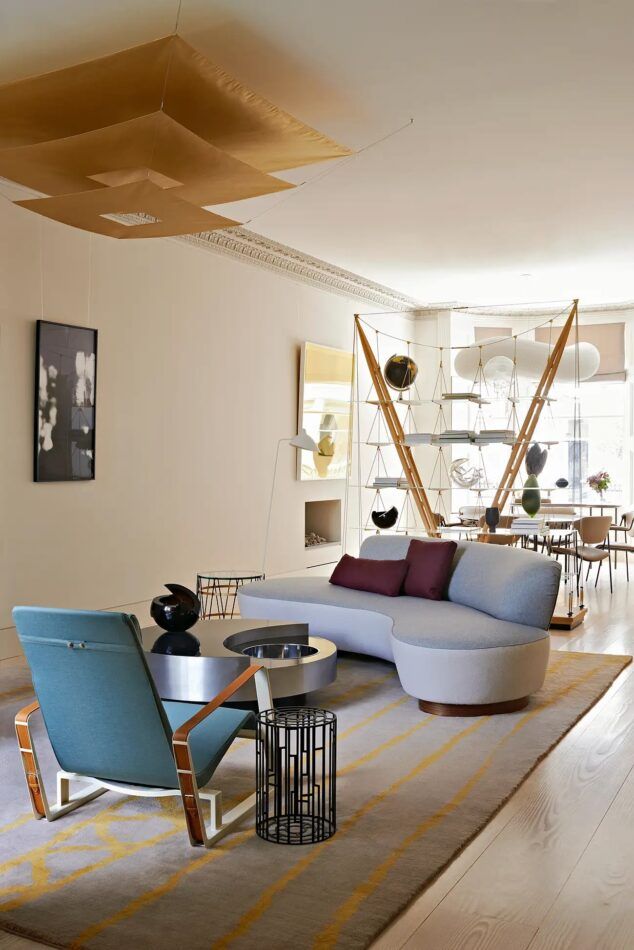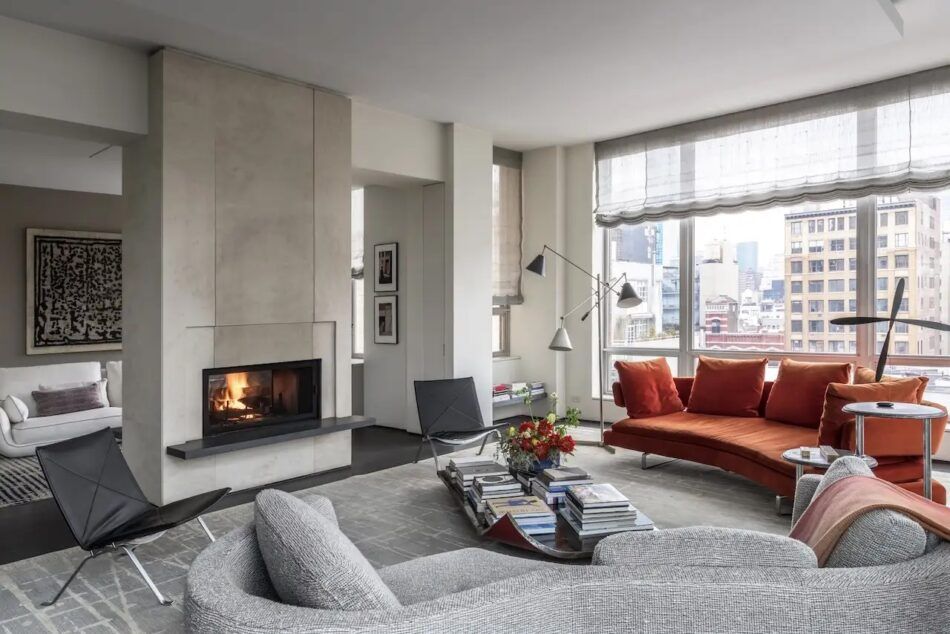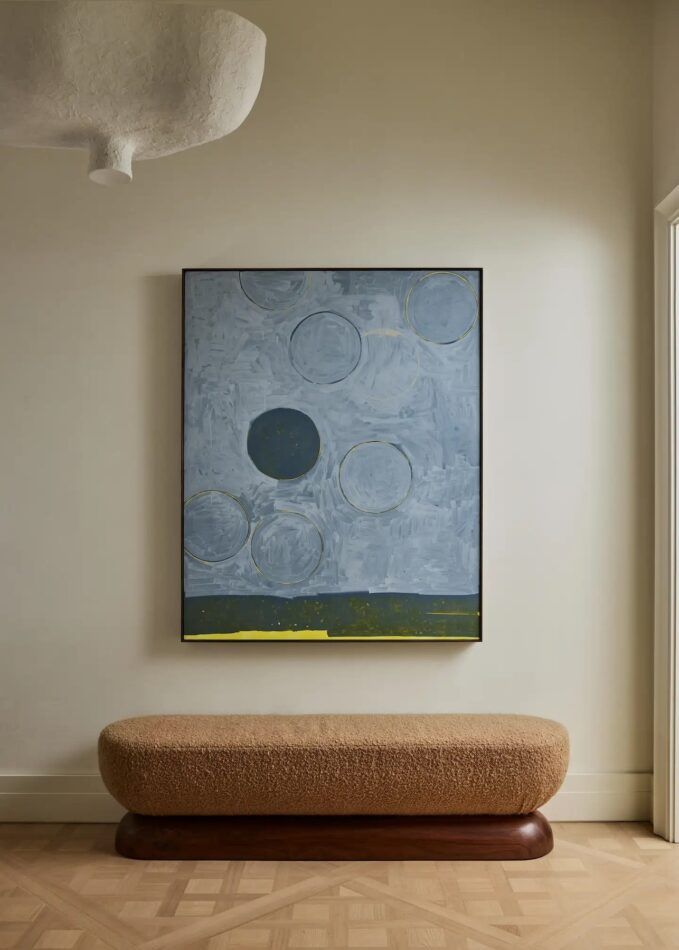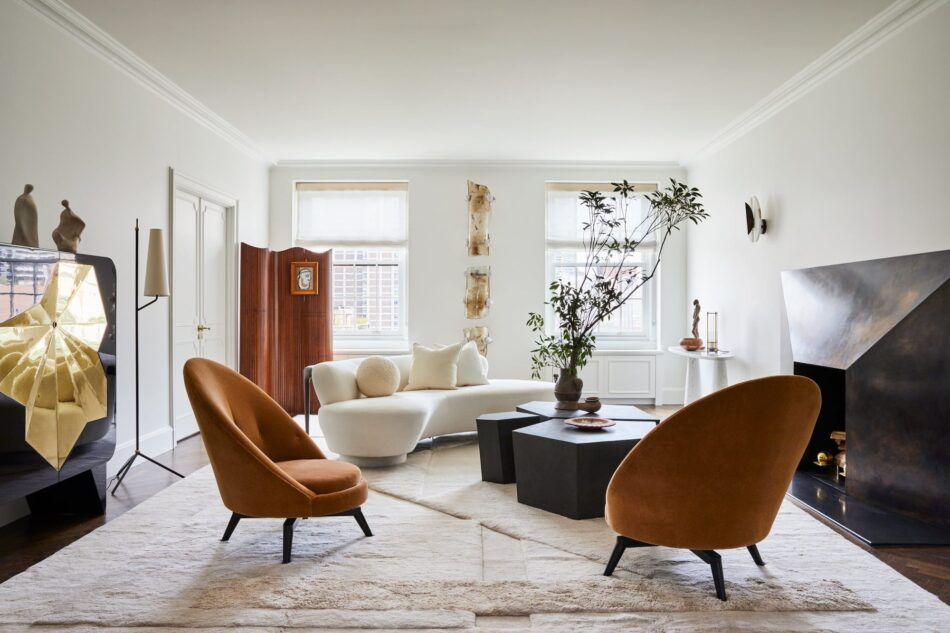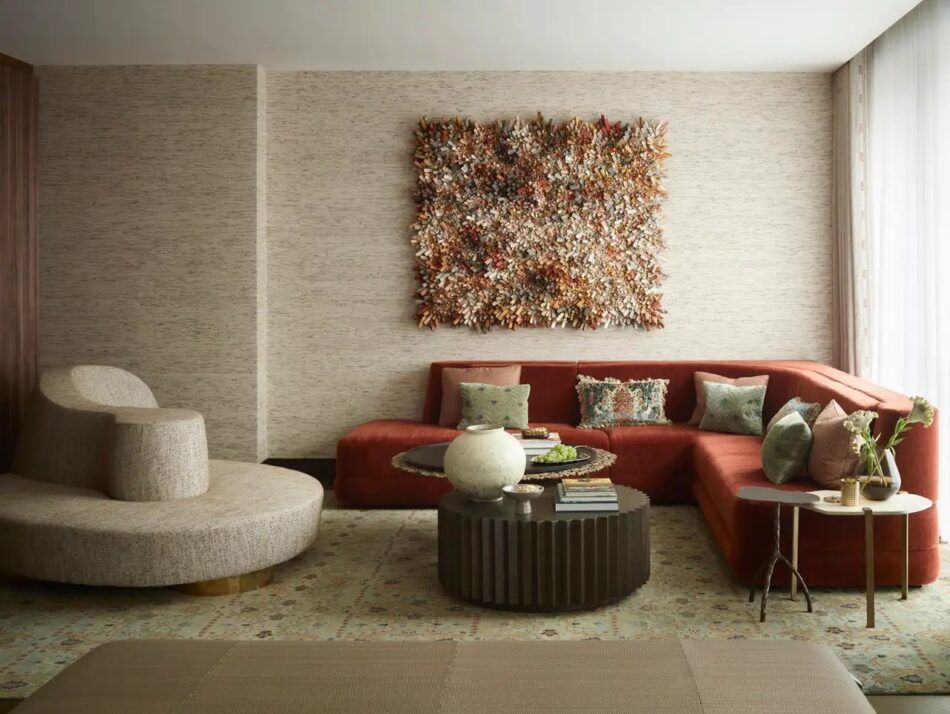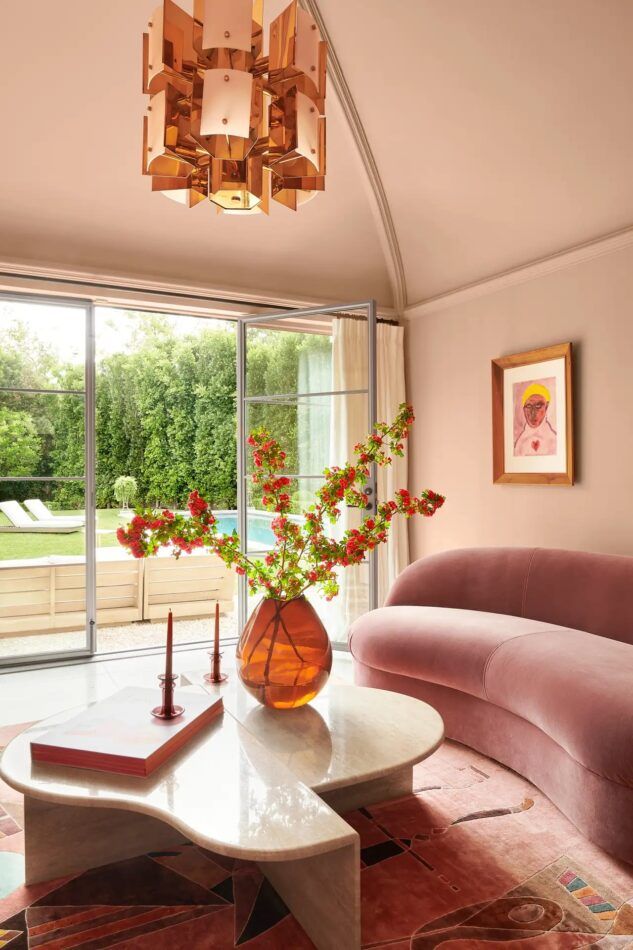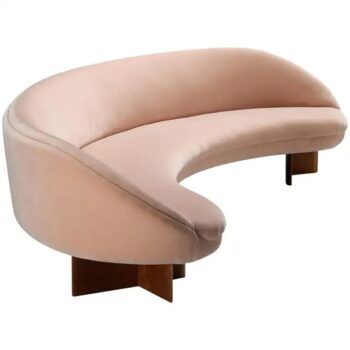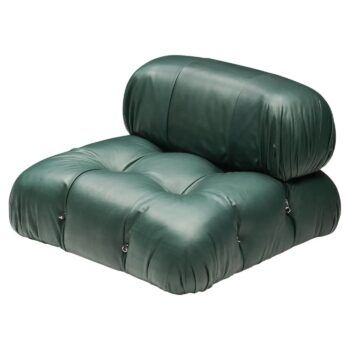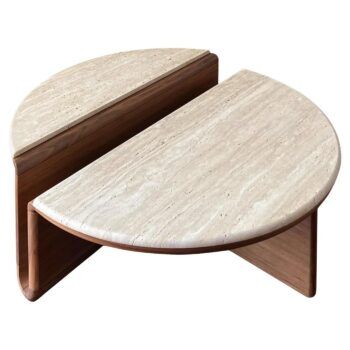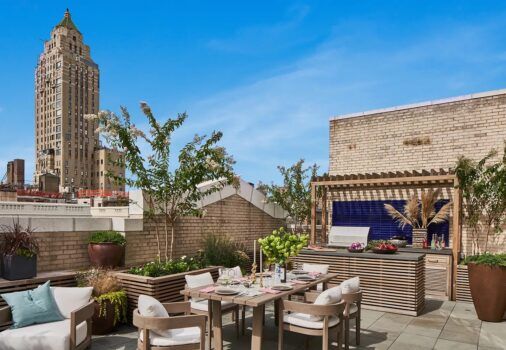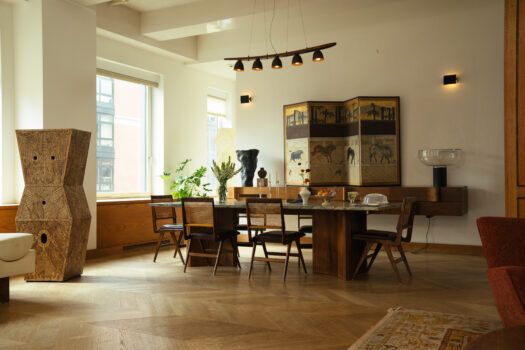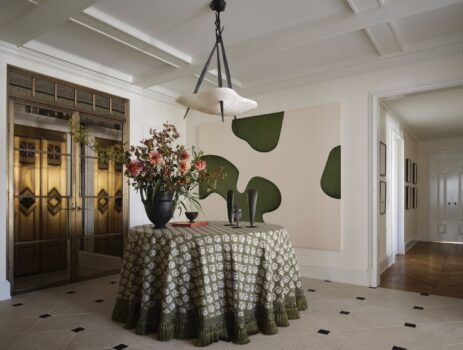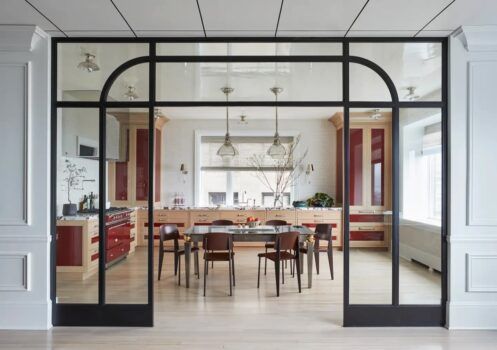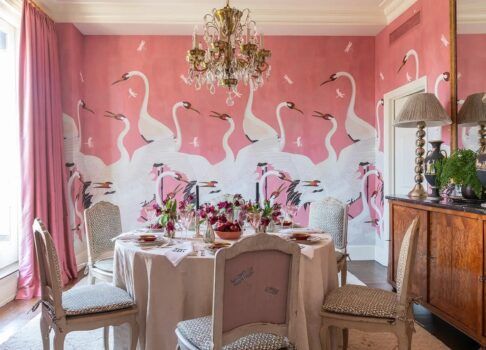The always-daring designer Robert Couturier played with contrasts across centuries in a spacious Fifth Avenue apartment, in New York City. “The entire apartment has a very traditional French background, with lots of 20th-century furnishings,” he says. “We painted the living room’s early-19th-century paneling in late-1960s colors — a foot in both eras!”
It’s a daring and unexpected time warp that somehow works, even several years after its completion. “The paneling of the room was so geometrical that it called out for a curve!” Couturier says.
A Vladimir Kagan sofa provides that relief, as it stretches around a tubular reflective cocktail table by Mattia Bonetti. A Louis XIV armchair, custom upholstered and painted in sync with the orange-and-white walls, and a mirrored fireplace surround inspired by Emilio Terry fill out the spirited ensemble.
“Round or curved furniture is super inviting and comfy,” Couturier says.
In their exuberant Omaha home, Mark and Mikal Eckström — the duo behind Studio Eckström — turned a long room just off the foyer into a guest reception area that doubles as a bar.
To offset the architecture’s straight lines, they layered in vivaciously swooping pieces. “We love curvaceous furnishings as they’re infinitely sexy and they break the rectilinear lines of a room,” says Mark.
At the center is a vintage borne settee, chosen to serve as a site for happy-hour tête-à-têtes. “The settee is a perfect spot to perch — cocktail in hand — and share secrets,” he adds.
A cascading glass side table by Laurel Fyfe introduces another wavelike accent, and a pair of Italian 1970s cabinets, sourced from MORENTZ via 1stDibs, flank a large-format Sasha Eisenman photograph of a post-party interior that reinforces the room’s wild, maximalist aura.
Waldo Works Studio founder Tom Bartlett was asked to design the interiors of a five-story London townhouse reworked by architecture firm Michaelis Boyd to suit it to serve as a couple’s city base.
On the ground floor, the great room combines living and dining spaces, separated by Franco Albini’s Veliero bookcase for Cassina, which nods to the clients’ passion for iconic mid-century design.
Pieces with sinuous outlines soften the room’s hard edges. A vintage discoid Willy Rizzo coffee table sits on a Christopher Farr rug, paired with a crescent-shaped Vladimir Kagan sofa and a B&B Italia armchair beneath Ingo Maurer’s three-layered paper pendant.
“Curvy furniture is actually very practical in longer, more narrow spaces — which you find a lot in ‘knocked-through’ terraced London townhouses,” the designer says. “They allow the flow around living room pieces to be more natural as you have to move about the house.”
Artworks by Becky Beasley and Lizzie McAlpine, along with a cloudlike pendant above the dining table, round out the lengthy space. “There is a certain louche ’70s quality to it,” Bartlett adds of curvy furniture, “which always feels quite appealing.”
Interior architect Elizabeth Steimberg opened up the first floor of a European couple’s penthouse duplex in New York’s Chelsea neighborhood to create a luminous, loft-like expanse “where the kitchen, dining area, TV room, living room and terrace flow in a casual and relaxed way,” she says.
In the living room, as a counterpoint to the architecture’s strong angles, she deployed seating defined by graceful arcs: a B&B Italia sofa in red velvet paired with one from Roche Bobois upholstered in custom black-and-white Studio Four fabric, set around a coffee table made by a Japanese artisan and purchased on 1stDibs.
Completing this conversation ring are twin low-slung Poul Kjærholm chairs and a 1950s Arredoluce Triennale floor lamp, all from 1stDibs. “What I love about the round furniture is how it creates a break into the more rigid hard lines in the angular space,” Steimberg says. “Curves are sexy, soft and inviting.”
This entry in an Upper East Side apartment updated by Monica Fried makes a striking first impression. A long oval bench by Cuff Studio, upholstered in bouclé, stretches across the wall on a rounded wooden base.
Suspended above, a plaster ceiling light by Pierre Augustin Rose crowns the space with undulating natural texture. On the wall, an abstract canvas by Sam Moyer, featuring seven circular forms floating on a field of pale blue, brings energy and movement.
“We love the juxtaposition of the geometric parquet floors and the curvy bench and plaster ceiling fixture in this Upper East foyer,” says Fried. “The atmospheric Sam Moyer painting adds to the circular drama.”
In a 1920s Park Avenue apartment in Manhattan, Jeremiah Brent designed a living room defined by smooth forms. At its heart is a Vladimir Kagan sofa, whose boomerang shape seems to hug the space.
Across from it, burnt-orange mohair swivel chairs add a bold chromatic punch, while a serpentine 1940s Baumann screen plays with shadow and movement. A contemporary Gloria Cortina cabinet acts as a foil for the ensemble with its sharp geometry.
Brent’s approach relies on balancing intentional tensions. “I love the juxtaposition of it all,” he says of mixing pieces from different eras and styles. “Ensure that there’s a cohesive thread throughout the space, whether it’s flooring, wall color or lighting. That consistency will tie together any unexpected layers of design.”
In the primary suite of a Silicon Valley family home, Heather Hilliard emphasized comfort, while introducing a dab of femininity. Custom walnut paneling provides a linear backdrop for layers of sumptuousness supplied by bespoke details like a Holland & Sherry–upholstered headboard, Pierre Frey–trimmed shams and a hide rug by Kyle Bunting.
To counter all the straight edges, Hilliard introduced pieces with rounded contours: Piet Boon barrel-back chairs, a Nickey Kehoe circular coffee table and rippling Paul Ferrante sconces.
“We introduced the rounded pink chairs and curved sconces to add softness and as a nod to the lady of the house,” the designer explains. “Rounded profiles allow for movement through the space, making the setting feel more relaxing and serene.”
Rachel Laxer reconceived a London apartment as a study in unconventional shapes and lush fabrics. In the living room, two rounded sofas strike up a dialogue: Charles Zana’s Alexandra sectional, upholstered in oxblood-red Pierre Frey mohair, brings plush depth, while a wave-like Italian tête-à-tête from Watteeu embodies a more fluid gesture.
“Together, they create balance and set the tone for the rest of the home,” Laxer says
Custom circular coffee tables sit at the core of the grouping. Next to the Zana sectional are two tripod side tables: a velum one from Paolo Moschino and a bronze and shagreen piece. A moon jar vase adds a hand-thrown accent, while a floral Hands rug, a textured Phillip Jeffries wallcovering and a three-dimensional wall work from the client’s collection form an organic backdrop.
“Curved furniture softens a room and makes it more inviting,” Laxer says. “These forms are generous, they encourage flow, and they bring people together.”
Tiffany Howell, founder of Night Palm Studio, bathed this vaulted Los Angeles living room in shades of blush, creating a womblike space emphasizing ample contours.
A pair of kidney-shaped Vladimir Kagan for Weiman sofas, reupholstered in Métaphores velvet, face off across custom biomorphic travertine coffee tables.
Vintage Karl Springer–style side tables with lacquered goatskin tops add polish, while a tiered brass chandelier and a cubist Turkish rug, both from 1stDibs, layer in gleam and pattern.
For Howell, curves are a way to bring playfulness into a refined interior. “Have fun with a few statement pieces — let them be the stars of the room,” she advises. “If it’s a vintage piece, give it a twist with an unexpected fabric.”

